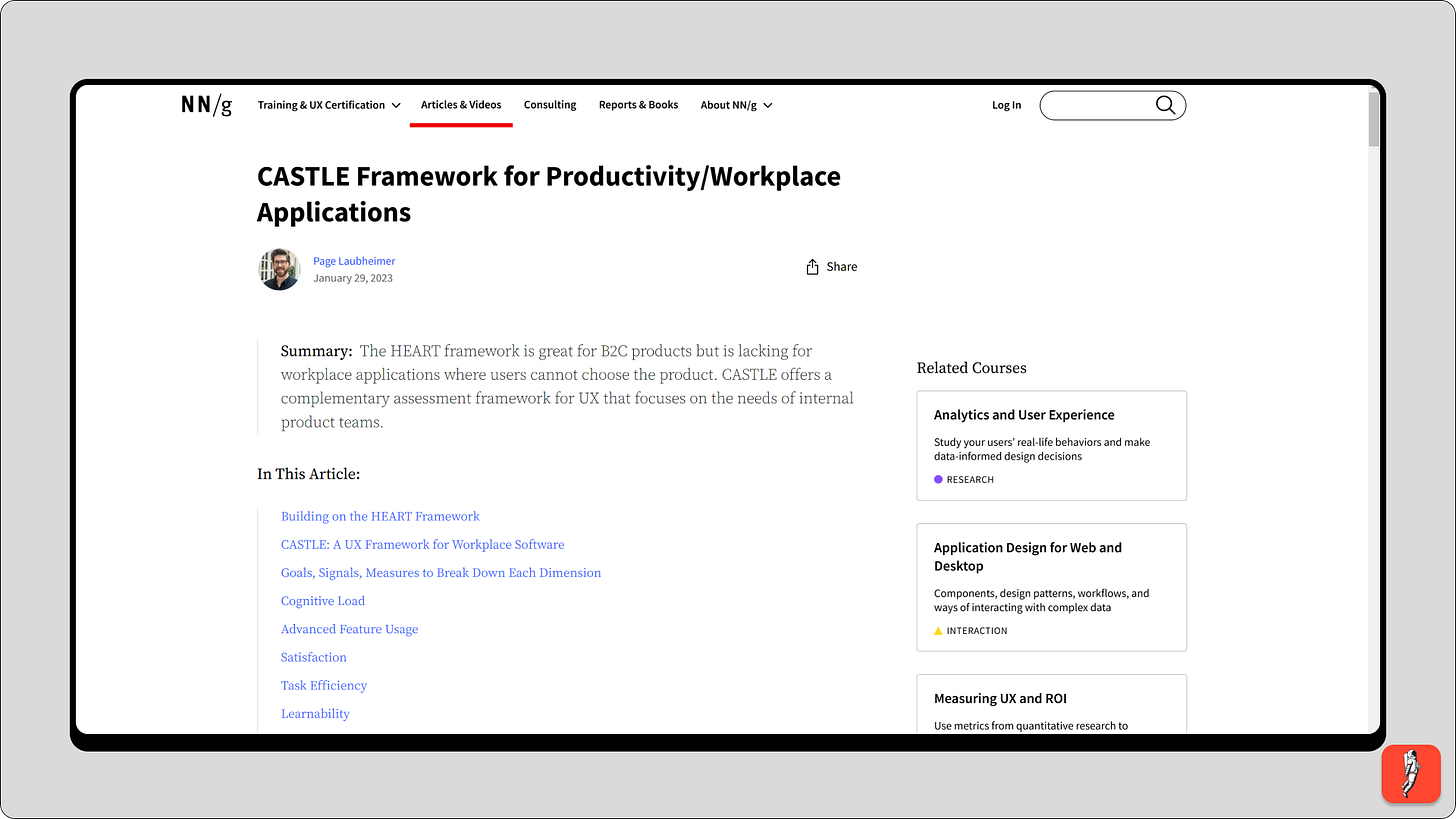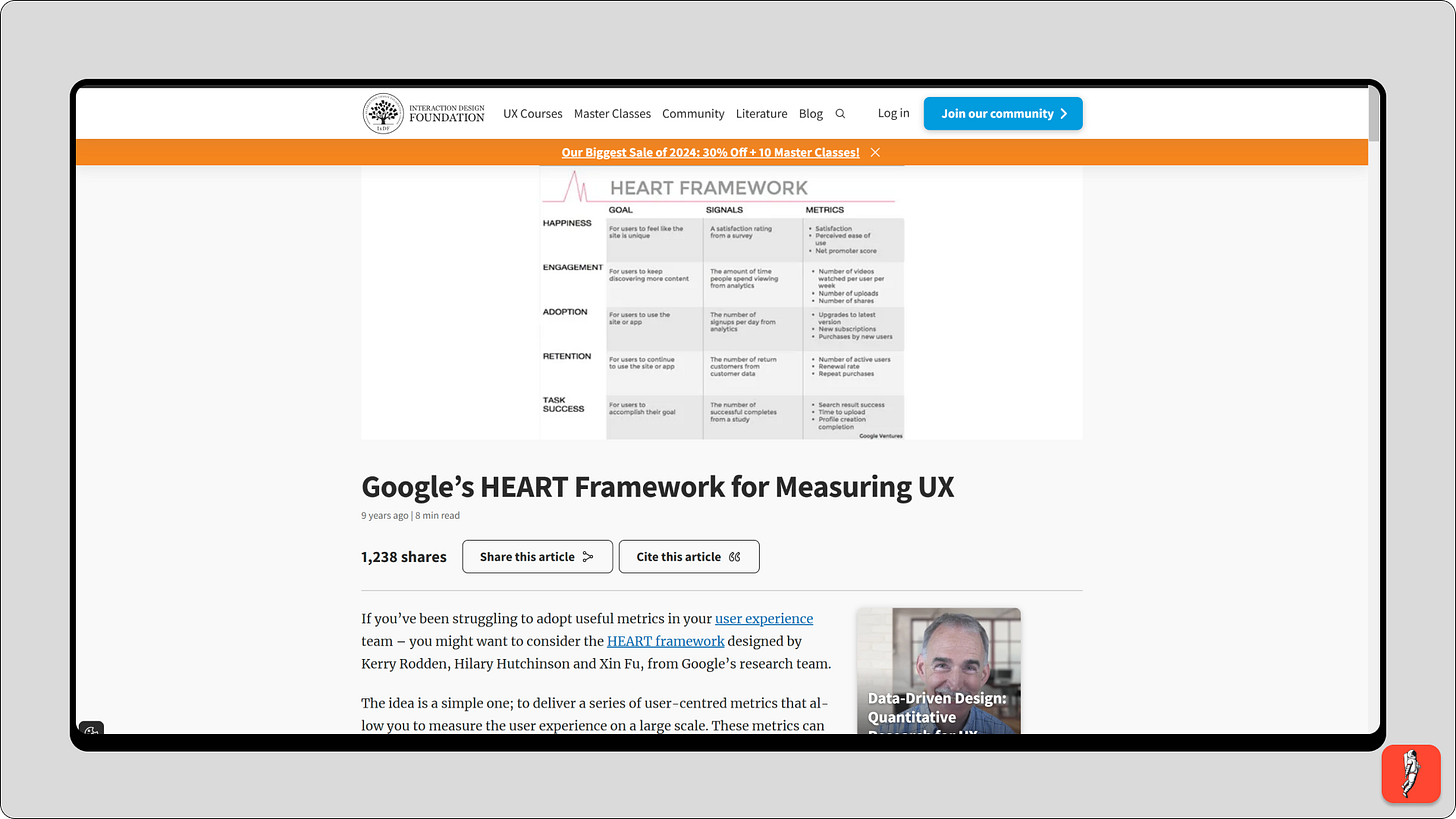Proving UX Value: Frameworks to Showcase Impact
Learn how the CASTLE and HEART frameworks can help you measure success, build trust, and position UX as a driver of business growth.
As we near the end of the year…
I’ve been reflecting on one of my 2024 goals: to do at least one thing better every day. Whether big or small, the focus has been on intentional improvement. It’s a simple mindset, but one that’s shaped the way I approach both my personal life and my work.
It’s that same spirit of growth that inspired me to write this article. Because just like in life, growth in UX doesn’t happen by accident. It requires intentionality, structure, and the right tools to drive progress.
The Challenge: Proving UX Value
As a designer, you already know the immense value UX brings. But let’s be honest: proving that value to others can feel like an uphill battle, especially in organizations with low UX maturity.
Have you ever found yourself in this situation?
You’re unsure how to showcase the impact of your team’s work.
You’ve relied on anecdotal evidence that doesn’t quite resonate with leadership.
You’ve felt like you’re missing opportunities to demonstrate UX’s real value.
If any of this rings true, you’re not alone. It’s a common challenge for UX teams, but the good news is that it’s one you can tackle with a more structured approach. Frameworks give you the tools to connect your design efforts to outcomes that matter to stakeholders, making it easier to demonstrate the value UX brings.
In this article, I’ll introduce you to two powerful frameworks—CASTLE and HEART—designed to help you showcase UX impact, whether you’re improving internal tools or customer-facing products.
Table of Contents
Introducing the CASTLE Framework
Introducing the HEART Framework
Introducing the CASTLE Framework 📊
Best for: Internal tools where productivity and efficiency matter most.
When you’re designing tools for internal teams, leadership often scrutinizes their ROI. The CASTLE framework, developed by Nielsen Norman Group, helps you showcase UX’s role in driving outcomes leadership cares about—like productivity and accuracy.
Here are the six core CASTLE metrics:
Conversions: How often users complete key tasks (e.g., submitting a report).
Adoption: How many users adopt a tool or feature over time.
Satisfaction: User happiness, measured via surveys or ratings.
Task Success: How efficiently users complete tasks (e.g., reduced errors, faster completion).
Loyalty: Users’ likelihood to continue using or advocating for the tool.
Engagement: How often users interact with the tool and rely on it.
Internal tools are all about improving workflows. CASTLE makes it easy to quantify UX’s impact with metrics like task success and adoption rates.
Example: Redesigning a dashboard could result in:
Faster task completion.
Higher adoption rates.
Improved user satisfaction.
These outcomes resonate with leadership because they directly translate to time savings and productivity gains.
Pro Tip: Start small. Pick 2–3 CASTLE metrics that align with leadership’s goals. If productivity is their priority, focus on task success and adoption rates.
Introducing the HEART Framework ❤️
Best for: Customer-facing products where engagement and satisfaction drive success.
When designing apps, websites, or platforms, the HEART framework, developed by Google Ventures, is your go-to tool. It tracks UX success across the user journey with five key metrics:
Happiness: User satisfaction (e.g., CSAT scores, NPS).
Engagement: How often and deeply users interact (e.g., daily active users).
Adoption: How many new users start using a feature or product.
Retention: How many users return over time.
Task Success: How effectively users complete tasks (e.g., error rates, completion times).
Pro Tip: Pair HEART with the Goals-Signals-Metrics (GSM) method to make it actionable:
Goals: Define what you want to achieve (e.g., increase retention).
Signals: Identify user behaviors that signal success (e.g., daily logins).
Metrics: Choose the data points to measure progress (e.g., DAU).
Driving UX Advocacy Through Frameworks 🚀
CASTLE and HEART go beyond just measuring results—they help you build trust and position UX as a strategic driver of success.
Here’s how to start:
Pick small, measurable wins (e.g., improving onboarding or key workflows).
Use the frameworks to demonstrate UX’s impact.
Create momentum by tying UX metrics to business outcomes.
Over time, you’ll not only prove UX’s value but also build the credibility needed to influence strategy and secure resources.
Make Your Impact Visible 🎯
Proving the value of UX doesn’t need to be a struggle. Frameworks like CASTLE and HEART give you the structure to connect UX to outcomes stakeholders care about—like increased adoption, faster task completion, and higher retention.
When you make your impact visible, you don’t just build credibility. You turn UX into a recognized driver of growth within your organization.
Start small. Focus on measurable wins. Use these frameworks to tell a compelling story of progress and success—one that positions UX exactly where it belongs: at the heart of business impact.
I’d love to hear how you’re applying these frameworks in your own work. What strategies have worked for you to showcase UX value? Let’s keep the conversation going—drop a comment or reply with your experiences. I’m all ears!



